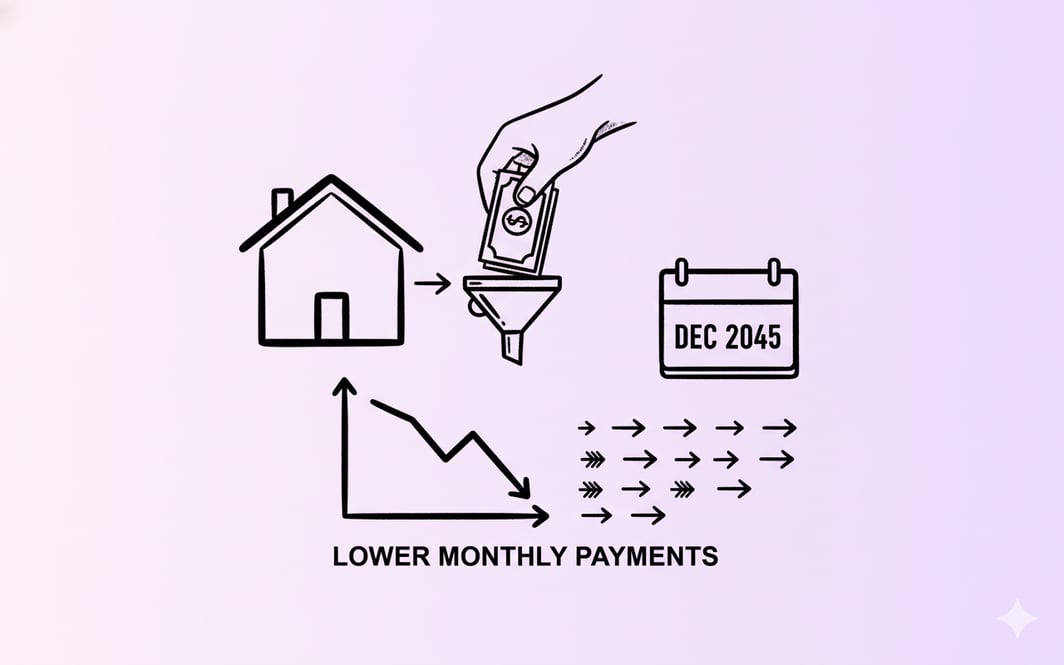When seeking a home loan, you’ll see two main numbers: the advertised interest rate and the comparison rate. Both indicate the loan’s cost but mean different things. This article clarifies each rate, its calculations, the rules, and their implications. We’ll discuss why banks may show a low advertised rate paired with a higher comparison rate (or vice versa), how loan features affect these rates, and share practical tips for consumers and educators.
Understanding Advertised Rates and Comparison Rates
Definition and calculation of comparison rates
The advertised interest rate (sometimes called the "headline rate") is the basic percentage rate that lenders promote in marketing materials. This percentage represents the cost you pay each year to borrow money. The advertised rate does not include any additional fees or charges that you may incur.
The comparison rate gives a broader view of a loan’s true cost by combining the interest rate with most fees over the term. It’s a single percentage reflecting the annual total cost, based on a set loan amount and term.
In Australia, the comparison rate calculation is standardised under the National Credit Code (NCC) and related regulations. The calculation assumes:
- A fixed loan amount and term (usually $150,000 over 25 years for home loans)
- This includes the nominal interest rate, which is the stated percentage paid on the loan, plus most fees and charges you pay over the life of the loan.
- Exclusion of certain fees, such as government charges and conditional fees (e.g., early repayment fees)
For example, a lender might advertise a nominal interest rate of 5.49%, but the comparison rate could be higher, such as 5.75%, reflecting additional ongoing fees and charges.
The comparison rate thus serves as a standardised metric enabling consumers to compare the real cost of different loan products more effectively.
Fees and Charges included and excluded in comparison rates
Included fees and charges:
- Upfront fees, such as application or establishment fees
- Ongoing fees, including monthly or annual service fees
- Settlement and administration charges that are generally payable over the life of the loan
Excluded fees and charges:
- Government taxes or charges (e.g., stamp duty)
- Conditional or contingent fees like early repayment penalties or late payment fees
- Charges that apply only in special circumstances
This method provides a realistic representation of most costs and avoids distorting the comparison rate with rare or one-time fees.
By including most fees, comparison rates help you spot loans that look cheap at first but have hidden costs. Still, since some fees aren’t included, you should check the product disclosure statement to see all possible charges.
Comparison rate calculations example
Example:
- Loan amount: $150,000
- Term: 25 years
- Nominal interest rate: 5%
- Application fee: $1,000
- Monthly service fee: $10
When you spread the fees over the life of the loan and add them to the interest, you might get a comparison rate of 5.5%. This means the loan actually costs more than the headline rate alone would suggest.
Variations in comparison rates across different loan types
Comparison rates vary significantly between loan types due to differences in interest rates, fees, loan terms, and risk profiles.
- Fixed-rate loans often have higher comparison rates due to risk premiums and hedging costs for fixed terms. Variable-rate loans may start lower but involve fluctuating payments.
- Personal Loans: Generally unsecured and shorter-term, personal loans have higher comparison rates due to higher interest rates and fees, such as establishment and monthly service fees.
- Car Loans: Similar to personal loans, car loans often have higher comparison rates due to shorter loan terms and additional fees.
- Business Loans: Typically have higher comparison rates, reflecting higher risk and funding costs.
Next, let's examine why banks may choose to advertise a low headline rate alongside a higher comparison rate, or vice versa.
Banks’ advertising strategies reflect market positioning and regulatory constraints:
- A low headline rate and a higher comparison rate attract attention and ensure compliance, indicating higher fees or features that increase the total cost.
- A higher headline rate with a lower comparison rate suggests fewer fees or simpler loan features, appealing to informed consumers focused on total cost.
Banks compete, meet customer demand, and comply with rules without misleading ads.
Impact of Loan Features on Comparison Rates
Effect of Fixed vs Variable interest rates on comparison rates
The type of interest rate significantly influences the calculation and practical usefulness of comparison rates.
- Fixed-interest-rate loans have a locked-in rate for the term, making comparison rates more stable and predictive of the total cost.
- Variable-rate loans fluctuate with market and central bank rates, resulting in variable payment amounts over time.
Since comparison rates assume the interest rate remains the same, they may not accurately reflect the actual cost of variable loans, which can fluctuate over time.
Influence of loan features like offset accounts and redraw facilities
Loan features that offer repayment flexibility or interest savings are often not fully accounted for in comparison rates.
- Offset accounts reduce interest payable by offsetting the loan balance with deposits in linked accounts, effectively lowering the cost.
- Redraw facilities allow borrowers to withdraw extra repayments, providing them with additional liquidity.
- Rate freezes or promotional periods temporarily reduce interest rates.
Because comparison rates don’t include these extra features, you may view some loans as more expensive than they actually are. If you use these features, the comparison rate may not accurately reflect your actual costs.
Limitations of comparison rates in reflecting true loan costs
While comparison rates improve transparency, they have limitations:
- Exclusion of conditional fees and certain government charges may result in actual costs being higher.
- Assumption of a fixed loan amount (the set dollar figure borrowed) and term (the length of the loan in years) may not match individual borrowing patterns.
- Non-inclusion of benefits from flexible loan features limits accuracy.
Use comparison rates as a helpful starting point, but also consider your own situation and the loan’s features, and read all the details carefully before choosing a loan.
Regulatory Framework and Compliance in Advertising Rates
Key regulations governing advertised and comparison rate disclosures
In Australia, disclosure of advertised and comparison rates is governed chiefly by:
- The National Consumer Credit Protection Act 2009 (National Credit Act), particularly Part 10 of the National Credit Code, requires the inclusion of comparison rates in advertisements for fixed-term loans intended for personal/domestic use.
- ASIC’s Regulatory Guide 234 outlines best practices for advertising financial products, calling for clear, truthful, and non-misleading rate disclosures, as well as mandatory comparison rate warnings.
- The Australian Competition and Consumer Commission (ACCC) enforces advertising standards under Australian Consumer Law against misleading conduct and deceptive advertising.
Recent regulatory changes and enforcement actions
Recent years have seen increased regulatory scrutiny to enhance transparency and consumer protection:
- ASIC has updated regulatory guides and intensified enforcement against misleading advertising.
- The ACCC has issued infringement notices to banks for inaccurate disclosures, aiming to improve data quality.
- New guidance under the Delivering Better Financial Outcomes Act 2024 encourages clearer disclosures, including flagging deferred fees.
These steps have prompted lenders to prominently display comparison rates alongside advertised rates, thereby helping to reduce consumer confusion and improve market fairness.
Prescribed methods and formats for comparison rate presentation
ASIC mandates:
- Calculate comparison rates using the National Credit Code’s method, factoring in interest plus most fees.
- Accompanied by a comparison rate with a clear warning stating it is indicative only and specific to the example advertised.
- Prominent, legible display of comparison rates alongside headline rates in all advertisements.
- Exclusion of certain fees (government, early repayment) from the calculation, but disclosure of those fees elsewhere.
These rules maintain consistency, reduce confusion, and support better decisions.
Advertising Practices and Consumer Protection
Strategic use of headline rates vs comparison rates in marketing
Banks often advertise low headline rates paired with higher comparison rates for strategic reasons:
- The low headline rate captures consumer attention and generates inquiries due to its psychological appeal.
- The comparison rate, which includes fees, ensures compliance and transparency.
- By showing both rates, banks can market their loans effectively while also acting responsibly, building trust, and avoiding regulatory breaches.
Some lenders may also advertise higher headline rates with lower comparison rates when fees are minimal, appealing to savvy consumers who focus on total costs.
Best practices for visual design and placement of rates in marketing materials
Regulatory guidelines and industry best practices recommend:
- Prominent, bold display of the headline interest rate to attract initial attention.
- Clearly display the comparison rate, including any required warnings.
- Never hide comparison rates in small print.
- Use of plain language and transparent fee disclosures.
- Maintain consistent messaging across all channels to minimize confusion.
Effectiveness of current advertising practices in protecting consumers
While regulations help transparency, challenges remain: Drip pricing can mislead consumers.
- Vulnerable consumers, including non-English speakers, still face difficulties understanding rates.
- Enforcement actions and consumer education are ongoing to address these gaps.
Current practices are a good start, but clearer consumer communication is still needed.
Consumer Understanding and Communication Strategies
Consumer comprehension and behavior regarding advertised vs comparison rates
- Many consumers focus on headline rates and overlook comparison rates.
- Vulnerable groups (younger people, females, non-English speakers) have lower comprehension and face more financial difficulties.
- Consumers often do not fully appreciate the impact of fees and loan features on total cost.
Communication tools and strategies for vulnerable consumers
Regulators and consumer groups employ:
- Plain language educational materials explaining comparison rates.
- Enforcement actions to ensure truthful advertising.
- Tailored messaging and outreach to vulnerable demographics.
- Tools like calculators and interactive guides on platforms such as ASIC’s MoneySmart.
Effective messaging strategies for different demographic segments
Data-driven personalisation and behavioural insights help:
- Tailor messages to demographic-specific cognitive biases.
- Use natural language processing to analyse and optimise messaging.
- Highlight total loan costs clearly, avoiding jargon.
- Reinforce the importance of comparison rates in decision-making.
Frequently Asked Questions (FAQs)
The comparison rate combines the nominal interest rate with most fees and charges payable over the loan term, assuming a fixed loan amount and term (usually $150,000 over 25 years). It excludes government fees and conditional fees, such as early repayment charges. The result is an annual percentage reflecting the true cost of the loan.




